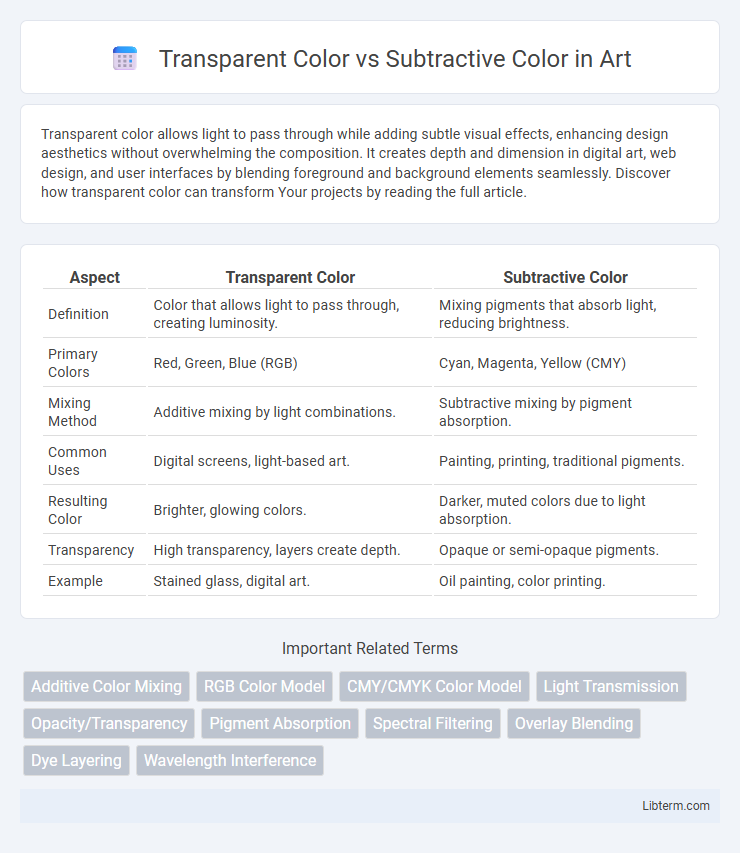Transparent color allows light to pass through while adding subtle visual effects, enhancing design aesthetics without overwhelming the composition. It creates depth and dimension in digital art, web design, and user interfaces by blending foreground and background elements seamlessly. Discover how transparent color can transform Your projects by reading the full article.
Table of Comparison
| Aspect | Transparent Color | Subtractive Color |
|---|---|---|
| Definition | Color that allows light to pass through, creating luminosity. | Mixing pigments that absorb light, reducing brightness. |
| Primary Colors | Red, Green, Blue (RGB) | Cyan, Magenta, Yellow (CMY) |
| Mixing Method | Additive mixing by light combinations. | Subtractive mixing by pigment absorption. |
| Common Uses | Digital screens, light-based art. | Painting, printing, traditional pigments. |
| Resulting Color | Brighter, glowing colors. | Darker, muted colors due to light absorption. |
| Transparency | High transparency, layers create depth. | Opaque or semi-opaque pigments. |
| Example | Stained glass, digital art. | Oil painting, color printing. |
Introduction to Color Systems
Transparent color systems rely on additive color mixing, combining red, green, and blue light to produce a wide range of colors through light transmission, commonly used in digital displays and lighting. Subtractive color systems use cyan, magenta, yellow, and black (CMYK) pigments or dyes that absorb specific wavelengths of light and reflect others, essential for print media and physical artwork. Understanding the fundamental differences in how these systems manipulate light and pigment is crucial for applications in design, photography, and color reproduction technology.
Defining Transparent Color
Transparent color refers to pigments or dyes that allow light to pass through them, resulting in a luminous and layered visual effect often used in painting and digital design. Unlike subtractive color, which relies on the absorption and subtraction of light wavelengths to produce color, transparent color maintains light transmission, enhancing depth and vibrancy in artworks. This characteristic makes transparent color essential for glazing techniques and creating dynamic color interactions in both traditional and digital media.
Understanding Subtractive Color
Subtractive color refers to the process of color mixing that involves the absorption and reflection of light by pigments or dyes, commonly used in printing and painting. This system relies on primary colors cyan, magenta, and yellow, which combine to absorb varying wavelengths of light, resulting in the perception of different colors. Understanding subtractive color is crucial for accurately reproducing colors in physical media, as it contrasts with transparent color models that depend on emitted light rather than reflected light.
Key Differences Between Transparent and Subtractive Color
Transparent color allows light to pass through, enabling the background or underlying layers to influence the final hue, while subtractive color relies on pigments that absorb certain wavelengths and reflect others, producing color by removing light. Transparent colors are typically seen in mediums like stained glass or digital layers with opacity, whereas subtractive colors are fundamental in printing and painting, using cyan, magenta, yellow, and black (CMYK) to create a wide range of colors. The key difference lies in light interaction: transparent colors transmit light through the medium, while subtractive colors subtract light via pigment absorption.
How Transparent Color Works in Digital Media
Transparent color in digital media operates through the manipulation of alpha channels, which control the opacity of pixels, allowing underlying visuals to be visible through the color layer. This method relies on RGBA color models where the 'A' component defines transparency levels, enabling seamless blending and layering effects on digital screens. Unlike subtractive color mixing that uses pigment absorption, transparent color digitally adjusts light emission to create the perception of translucency and depth.
Subtractive Color in Print and Physical Media
Subtractive color in print and physical media relies on cyan, magenta, and yellow inks that absorb specific wavelengths of light, creating a broad spectrum of colors by subtracting light. This process is essential for producing accurate and vibrant images on paper, as overlapping inks reduce reflected light to render the desired color. The subtractive method contrasts with transparent color systems, which are additive and blend light emissions rather than ink absorptions.
Applications of Transparent Color in Design
Transparent color enhances visual depth and light interaction in digital and graphic design, creating effects that mimic real-world translucency. It is crucial in UI/UX design for layering elements without obscuring content, improving readability and user engagement. Transparent colors also play a key role in animation and motion graphics to simulate natural lighting and reflections accurately.
Real-World Uses of Subtractive Color Models
Subtractive color models, such as CMYK, are essential in printing industries where inks absorb specific wavelengths to create a wide spectrum of colors on paper. Real-world applications include color printing for magazines, packaging, and textiles, where precise color reproduction depends on the layering of cyan, magenta, yellow, and black inks. Transparent colors, used in digital screens, blend light additively, contrasting with the subtractive mixing that physically removes wavelengths through pigments or dyes.
Advantages and Limitations of Each Color Method
Transparent color offers vibrant, luminous qualities ideal for layering and achieving depth in artwork, with advantages including light transmission and blending flexibility; however, it can lack opacity and may require multiple layers for richness. Subtractive color relies on pigment absorption, providing stronger coverage and durability in printing and painting, yet it often results in muted hues and color shifts due to ink layering and light absorption. Each method serves distinct artistic and practical purposes, balancing between vivid transparency and solid opacity based on project needs.
Choosing Between Transparent and Subtractive Color for Your Project
Transparent color allows light to pass through, creating luminous effects ideal for glazing, stained glass, and layers that require depth and light interaction. Subtractive color, used in printing and painting, relies on pigments that absorb specific wavelengths, producing richer, more solid hues suitable for opaque applications and precise color matching. Choosing between transparent and subtractive color depends on your project's need for light transmission, vibrancy, and layering complexity.
Transparent Color Infographic

 libterm.com
libterm.com